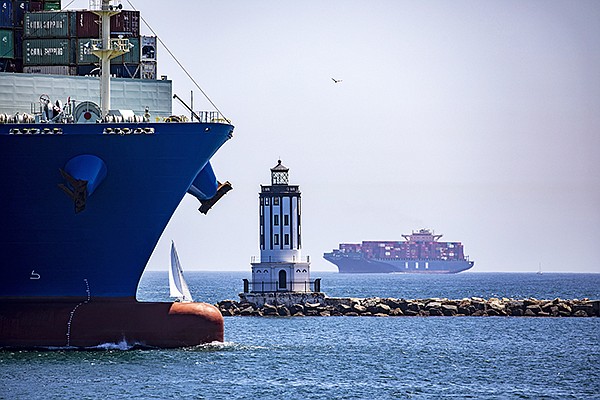IMPORT/EXPORT
Record Cargo Numbers for August at Port of Los Angeles Could Foreshadow Trouble
After moving 861,081 20-foot equivalent units—or TEUs—the Port of Los Angeles reported this week that it has set a new single-month cargo record for the month of August. With a 4.2 percent increase over August 2018, the San Pedro, Calif.–headquartered agency revealed that last month was the busiest in its 112-year history.
“Our strong volume growth this year is due in part to our global supply-chain relationships, aggressive marketing and improvements in operational efficiencies,” Port of Los Angeles Executive Director Gene Seroka said in a statement. “We continue to build value with the Port Optimizer, a digitization tool that increases the visibility of incoming cargo and improves logistics planning and overall efficiency.”
At first glance, a record increase would seem to be a harbinger of prosperity for the future, but, in a trade climate marked by uncertainty, bigger isn’t always better, according to the agency. During a Sept. 4 meeting of the Los Angeles City Council regarding the effects on Southern California of an escalating trade war between China and the United States, Seroka pointed out that record numbers have been driven by fear, a sentiment echoed by his colleague, Phillip Sanfield, director of media relations for the port.
“Throughout 2018, retailers and manufacturers pushed forward imports ahead of the tariffs trying to get their goods from China into the U.S. before the next round of tariffs,” Sanfield said. “That happened throughout 2018 and through much of 2019 as well. The result was the opposite effect of what the administration wanted.”
Noting that the port was in favor of tactics and policies that would aid in the growth of competition favoring American companies, in addition to expanding the job market in this country Seroka explained that his agency foresaw detrimental issues arising from a trade war with China. As the problematic trade relationship between the two countries escalated, the port warned of the negative effects that would be felt throughout Los Angeles and the nation by consumers as retail prices rise.
“We are the gateway to the Pacific here for Asian trade, and anything that happens on the global trade front is magnified in Los Angeles,” said Sanfield.
While sourcing goods from other countries is possible, shifting partnerships away from China isn’t an easy task, particularly when considering many of these relationships could have been in place and cultivated over a number of years.
“If we look under the hood at what this great year represented for the Port of Los Angeles, you’ll see that for every container we gain from new locations in Southeast and South Asia we lose 2.5 containers from China,” Seroka said. “In addition, because of retaliatory tariffs and other policies, the American exporter has been harmed irreparably. It will take seven Vietnams to make up for the loss of cargo in China due to these policies.”
During his time addressing the city council, Seroka illustrated that while imports from China fell 9.6 percent and increased 9.0 percent from all other nations for the period of January through June 2018 compared with the same time period in 2019, exports to all other countries fell by 1.1 percent and decreased 22 percent for goods exported to China.
“The stress that this policy has placed on our workers and companies will also be difficult to recover from in the future,” Seroka said during the meeting. “We’ve simply seen more [imports] trying to come into the United States in a choppy fashion and a lessening of exports widening the trade gap, which is counter to what this policy was originally designed to do.”
Despite the record numbers in August, representatives at the Port of Los Angeles don’t foresee the trend continuing. Now that higher tariffs have been enacted as of Sept. 1, it is likely that U.S. importers of goods from China have stockpiled these items, which could send cargo numbers for the year into decline.
“We’re up year over year. We’ve had rec-ord growth, but we see some yellow flags ahead in the next few months,” Sanfield said. “[Last year], there was an import surge to beat the tariffs, which were coming Jan 1. We don’t expect those kinds of numbers year over year. September, which comes out next month, will likely be down compared to last September and the same for October, November and December.”
To monitor movement among shipments, the Port of Los Angeles is prepared to utilize its cutting-edge Port Optimizer technology. Through a partnership with General Electric, the Port of Los Angeles implemented this software to improve its vision of cargo that is imported, thereby helping to monitor port operations, which Sanfield noted relates to approximately one in nine jobs, or 1 million jobs, in Southern California.
“Ninety percent of world trade moves on the water,” he said. “The one thing that shippers and our industry don’t like is uncertainty. That is all we’ve seen in the last 18 months. In the maritime industry and logistics world this has created a lot of tension.”
While the Port of Los Angeles is preparing for what could be a rough few months ahead, there is hope for the industry as the organization called upon representatives for assistance. During his meeting with councilmembers, Seroka explained that the time has come to work hard in the interest of improving trade relations.
“We’ve called for a negotiated settlement,” he said—“one that actively addresses the needs of the supply chain while understanding, as former U.S. trade representative and secretary of commerce Mickey Cantor, who is a resident of metro Los Angeles, states, ‘Rules-based trade is most important, and there are other remedies to follow through to make sure we’re all on an even playing field and we enhance the competitiveness of our city, our port and our nation.’”























